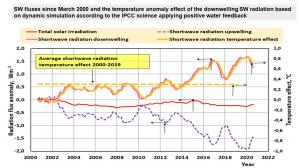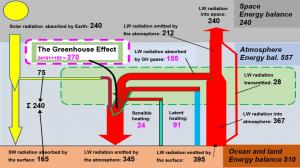Scientific flaws in IPCC climate models and the cover-up of problems in the IPCC AR6 report
IPCC climate models ignore the strong increase in solar radiation since 2001. IPCC tries to cover up the violation of physical laws of its GH effect definition
PORVOO, UUSIMAA, FINLAND, August 16, 2021 /EINPresswire.com/ -- According to the latest IPCC assessment report 6 (AR6), the observed temperature increase, and the calculated temperature increase according to climate models have been almost the same 1.3 °C from 1750 to 2020. The report shows a strong positive trend in solar shortwave radiation from 9/2000 to 6/2017, but its impact has been omitted in post-2000 warming calculations which can explain the high temperatures since El Nino of 2015-2016. For example, the temperature effect in 2019 is about 0.7 °C according to the AR6 science. Actually, the IPCC models give a 2019 temperature increase of 2.0 °C (1.3 °C + 0.7 °C). This 54 percent error is due to the positive water feedback applied in climate models, which doubles the impact of other climate forcings like that of greenhouse gases and which, according to this natural experiment by climate, does not exist.The amount of carbon dioxide in the atmosphere has increased by 32 % since 1750. According to the AR6, this is only due to man-made anthropogenic emissions staying there (remained, accumulated) by an average of 44 % per year and the rest has been absorbed by oceans and vegetation. Approximately 25 % of the atmospheric carbon dioxide changes annually from the oceans and vegetation. As a result, less than 6 % of the initial amount of carbon dioxide in the atmosphere remains after 10 years, and therefore the increased amount of carbon dioxide in the atmosphere cannot be entirely anthropogenic origin with a permille value of -28 ‰. The IPCC remains silent on permille values, as in the AR6 there is no word “permille”, which is a measure of the ratio of carbon isotopes and it has been used to analyze the origin of carbon dioxide, suitable for validating carbon cycle models.
The cover-up of this issue continues with the anthropogenic carbon dioxide lifetime in the atmosphere, which is now vaguely from hundreds of years to thousands of years. The removal rate of radioactive carbon from the atmosphere (a perfect tracer test for anthropogenic carbon dioxide) after 1964 is only 64 years. The recovery time of the total atmospheric amount of carbon dioxide to the level of 1750 can be estimated to be similar to that of its accumulation period, i.e. just under 300 years.
The AR6 report no longer shows the IPCC's very own definition of the greenhouse effect, except in the glossary. The definition does not contain anymore the description for how greenhouse gas absorption of 158 W/m2, which causes the greenhouse effect according to the IPCC, creates downward infrared radiation downwards on the ground of 342 W/m2. This is against fundamental physical laws because energy comes from nothing. The radiation to the surface consists of four energy fluxes, which according to the IPCC's energy balance are greenhouse gas absorption of 158 W/m2, latent water heat 82 W/m2, sensible heat (warm air) 21 W/m2, and solar radiation absorption in the atmosphere 80 W/m2. The three firstly mentioned energy fluxes totaling 261 W/m2 maintain the greenhouse effect.
By distorting the size of the greenhouse effect to the absorption of greenhouse gases alone, the IPCC is able to increase the contribution of carbon dioxide in the greenhouse effect from approximately 7,5 % to 19 %, and the temperature effect from 2.5 °C to 6.3 °C. This also means that the equations used by the IPCC to calculate the radiation forcing values and the global warming impacts of carbon dioxide for increasing carbon dioxide concentrations are not in line with the contribution of carbon dioxide in the greenhouse effect.
The IPCC's science as the basis on climate change in the Paris Agreement gives a strongly exaggerated warming capability to carbon dioxide. In 2019, the limit of 2 degrees was already exceeded according to the IPCC's climate models.
Antero Ollila
Aalto University (Emer.)
aveollila@yahoo.com
Legal Disclaimer:
EIN Presswire provides this news content "as is" without warranty of any kind. We do not accept any responsibility or liability for the accuracy, content, images, videos, licenses, completeness, legality, or reliability of the information contained in this article. If you have any complaints or copyright issues related to this article, kindly contact the author above.



